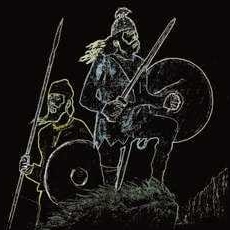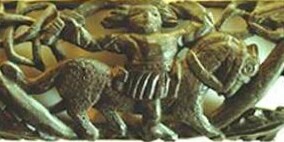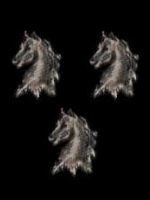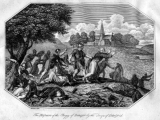Brochfael (Brochwel) Yagythrog (of the Tusks)
born 502 crowned 530 died 570 (560)
King of Powys
The "Yagythrog", "Yscythrog" or more correctly, "Ysgithrawe" [693] or "Ysgithrog" (horned) name relates to Brochwel's horned helmet.
Son of Cyngen Glodrydd and St.Tangwyst ferch Brychan.
 |
Brochwel became "the greatest of the princes of the line of Vortigern, Cadeyrn and Cadell. Moreover, he was a liberal benefactor of the church...[36]. However, Philip Yorke [222] in his book of 1799 says :- "Why Jestin ap Gwrgant, a petty Lord of Glamorgan, and a character in everlasting disgrace should be thus dignified (by being included in the five royal tribes) while he was the founder only of ignominy and loss of dominion to himself and of slaughter and slavery to his country, is very difficult to adjust; and that Brochwel Ysgythrog, a Prince of Powys in its highest splendour, having Shrewsbury (Pengwern) for his capital and a chief of great power and martial character, should have his name omitted even in the Fifteen (common) Tribes, is alike inscrutable."
In The Anglo-Saxon Chronicles, we read "The Anglo-Saxon advance was halted early in the 6th century, and there were 50 years of relative peace, until they won a decisive victory in 571." [51] [Battle of Bedford]
Nennius note "When they were defeated in all their campaigns, the English sought help from Germany, and continually and considerably increased their numbers, and they brought over their kings from Germany to rule over them in Britain. This continued down to the time of Ida who was the first king in Bernicia, that is, in Berneich." [219] [Ida began his reign in 547]
The famous Taliesin was Brochfael's bard for a time.....
I saw the oppression of the tumult, and wrath and tribulation,
The blades gleamed on the glittering helmets,
A battle against the lord of fame, in the dales of the Severn,
Against Brochwel of Powys, that loved my Awen.
{Book of Taliessin XIV}
Against Brochwel Powys; he loved my song
{Kerdd y Veib Llyr by Taliessin}
A battle against the lord of fame in the dales of Hafren,
 Prince Brochwel hunting |
Pistyll Rhaeadr, the highest waterfall in Wales, is the site of the old church of Pennant Melangell, named after an Irish virgin saint known as Monacella. The legend of Melangell has it that in the year 540 the "stunning" young woman Monacella, who had been living in a small hermitage in the wilds was confronted by the hunting hounds of Brochfael Ysgythrog as he hunted hares. The hare hid beneath her skirts and the dogs stood off spellbound. This so impressed Brochfael that he asked her to marry him and when she refused he gave her land to build a nunnery/monastery [11] [802].
Prince Brochwel is depicted out hunting on a late 15th-century rood screen at Pennant Melangell church (see on right).
 Arms of Brochfael Yagythrog |
The arms of Brochwel were "Sable, three nags' heads, erased argent" and represented the Saxon white horses, with their heads severed, and symbolised his victory over the Saxons at Chester in 564 A.D. [40]. According to Robert Blaney [223] and Roberts & Owen [36], the severed heads of Saxon horses represent trophies of the victorious Cymru (Welsh). Saxons rode such horses, and as the Welsh were pushed westwards victories against the enemy were important. The Celts left the severed heads in rivers, which was considered the source of natural power. This theory has been questioned by Edward Herbert Owen MITCHELL, who states the Saxons always fought as infantry [50], supported by Glen Ray Crack (East Sussex, UK) [352] and Bruce Kammer [353]
Another version of the origin of the three severed horse heads on the coat of arms was that the celtic "Brockweil" fought the Saxons on foot with a double headed axe. His claim was that he could take the horses head off on the back swing and the riders head off with the fore swing of his axe, and hence the horses heads depicted on the coat of arms.
This Coat of Arms is continued as the Blayney Coat of Arms.
While many genealogies like to trace back to Brochfael/Brochwell as seen by the use of his Coat of Arms, and Powys has frequently been called "the land of Brochwel", it was his grandfather, Cadel to whom this dynasty was subsequently named - i.e. the Cadelling.
Brochfael Yagythrog died about 560-70 and was buried at Pentrefoelas in Gwynedd. Apparently a grave of a six foot man, with a covering slab bearing the name "Brohomagli", has been uncovered there [11].
It has been claimed that it was under the protection of Brochwel Ysgythrog that the hierarchy of the British Church assembled in conference to give an answer to Augustin, an emissary from Rome (probably St Augustine of Canterbury meeting Welsh Bishops in 602 at Aust near Chepstow, or a later meeting in 604). Their reply was "We know of no obedience that he whom you call the Pope, or Bishop of Bishops, can command, claim or demand; the Bishop of Caerleon (St. Davidís) is alone, under God, our ruler to guide us right in the way of Salvation." Augustin replied "If you will not have peace from your brethren, you shall have war from your enemies; if you will not preach life to the Saxons, you shall receive death at their hands". St Augstine died in 605 but in 613 (under the influence of Aethelfrith, King of Northumbria, poured 50,000 men into Brochwel's territory in the Vale of Chester and 1,200 British Priests of the University of Bangor (Bangor Monachorum) at Bangor-is-y-Coed wearing their white vestments and totally unarmed, who had come out to aid by their presence or prayers the unequal contest, were massacred to a man.
 Aethelfrid's 1613 massacre of Bangor monks (c1802) |
This Scrocmail/Brochwel could not be our Brochfael who was born in 502 and the Battle of Chester (or Derva or Caer-Legion) occured in 613 (and the and the massacre at Bangor-is-y-Coed possibly in 1616 so he would have had to be 114 years old. The dates for this massacre at Bangor has been variously given as 605 through to 615. Furthermore Æthelfrith was born in 586 after the commonly accepted death of Brochfael Ysgythrog in 570. Brochfael Ysgythrog's grandson, Selyf Sarffgadau fell at the battle of Chester (613).
Note that this Bangor-is-y-coed is not the same as the current Bangor in Caernarvonshire, but in Flintshire, on the river Dee, about 20 km from Chester. In former times there was a very extensive monastery at this place. In addition to the students who were learning the sciences, there were 2400 religious persons who read the service in rotation, a hundred at a time, every hour in the twenty-four; so that the worship of God was continued by day and night throughout the year.
It would appear that the Brochwel who failed to protect the monks in 613 / 616 was in fact Brocmail, consul of the city of Legecester who, according to Geoffrey of Monmouth, "having a less army to withstand [Ethelfrid], at last quitted the city and fled, though not without having made a great slaughter of the enemy." [392]. The "Venerable Bede" however, paints an apparent cowardly figure with his histoy stating "About twelve hundred of those that came to pray are said to have been killed, and only fifty to have escaped by flight. Brocmail turning his back with his men, at the first approach of the enemy, left those whom he ought to have defended, unarmed and exposed to the swords of the enemies." [393]